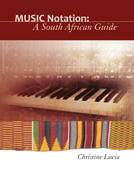Unisa Press
Music Notation
A South African Guide
| Author: | Christine Lucia |
|---|---|
| Published: | 2018-11-05 00:00:00.0 |
| ISBN: | 978-1-86888-568-8 |
| Number of pages: | 239 |
| This book is not available in electronic format |
|---|
About the book
Music Notation: A South African Guide presents a new and uniquely south African approach to learning about staff notation – especially for musicians who are educated in the tonic solfa system. As they work through the book, learners build up an understanding of each aspect of notation by experiencing it as music.
Tonic solfa is used in the earlier chapters to help learners relate the sounds to the concepts. In addition, the free CD offers 99 music clips played on a keyboard, illustrating some of the examples of notation given in the book. The book is aimed at mature school pupils and adult learners whose first language may not be English. However, it will be useful to students of music from any sector of society, whether they are enrolled in a formal course or want to find out more on their own. Each chapter is devoted to particular aspects of notation. Most of the chapters are built around a piece of music generally familiar to South Africans. Because South Africa has a strong vocal and choral culture, examples are often drawn from the choral repertory.
The book and CD include many examples of South African music, as well as samplings of classical western music from all eras, and jazz. Examples and exercises are drawn from this rich representation, and by means of self tests learners steadily become confident in reading and writing music in staff notation. They will also build up a strong knowledge of how music works, by seeing the structures of a wide range of music from diverse cultures in South Africa.
Table of content
Chapter 1: Tonic solfa
Chapter 2: From tonic solfa to staff notation
Chapter 3: The piano keyboard
Chapter 4: Rhythm and the extended staff
Chapter 5: Dotted crotchets and the bass clef
Chapter 6: Time signatures, rests, and the grand staff
Chapter 7: 4/4 time and transcription
Chapter 8: Major keys and aural exercises
Chapter 9: G major and F major
Chapter 10: Rhythms with a jazz feel
Chapter 11: African music and Western staff notation
Chapter 12: Western melody, expression, and 3/4 time
Chapter 13: African melody and Western notation
Chapter 14: Accidentals, semitones and tones
Chapter 15: Grouping notes
Chapter 16: More major keys, and expression marks
Chapter 17: B-flat major and A major
Chapter 18: Triplets, scale writing, and 6/8 time
Chapter 19: The minor key, 9/8, and 12/8
Chapter 20: Modulation, and the minor key
Chapter 21: Cycle of fifths Chapter 22: Diatonic intervals
Chapter 23: Chromatic intervals
Chapter 24: Cyclic form in folk music and jazz
Chapter 25: African cyclic form
Chapter 26: Triads and chords
Chapter 27: Modes in Western and African music
Chapter 28: Modes in art music, folksong and jazz
Chapter 29: Introduction to basic harmony
Chapter 30: Cadences in major and minor keys
